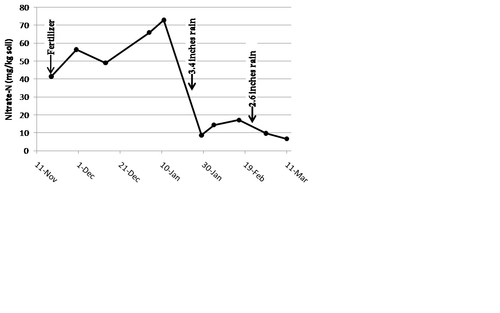The draft Agricultural Order issued by the Central Coast Regional Water Quality Control Board (CCRWQCB) on November 19 increased the regulation of discharges of nitrate-nitrogen to surface and ground water from agriculture. As written, all vegetable operations that produce over 1000 acres of lettuce, cole and several other ‘high risk’ crops and that use chlorpyrifos or diazinon are placed into Tier 3 compliance category which has specified regulations concerning the movement of nitrates to surface and ground waters. The new regulations may require growers to implement a certified Irrigation and Nutrient Management Plan (INMP) to document information on nitrogen applied to crops vs nitrogen removed by crops. This information would be used to calculate a nitrogen balance ratio and growers are given three years to demonstrate nitrogen balance ratios of 1.0 for annual rotations that are double cropped. In other words, if double cropped lettuce annually removes 240 lbs of N/A (120 lbs N/A/crop), the annual amount allowed to grow two crops of lettuce in order to comply with the nitrogen balance ratio would be 240 lbs N/A/year. Given current production practices and traditional fertilization programs, complying with these new restrictions will require many growers and their fertility consultants to make a shift in their approach to fertilization of leafy green vegetables.
The ultimate goal of the regulations issued by the CCRWQCB is to reduce the load of nitrate that is added to agricultural operations in the hope to improve the quality of ground and surface waters in the valley. It is therefore important for us to explore ways that we can be more efficient with applied nitrogen fertilizer and reduce unnecessary loading of nitrate when possible. The good news is that there are tools that can help growers manage nitrogen and safeguard yields in this new regulatory era. If anyone is interested in more information on this subject, there are a number of Monterey County Crop Notes articles that deal with this issue. One point that I will make today regarding the lowest hanging fruit in terms of nitrogen savings in lettuce production is the use of fall applied preplant nitrogen. We observed rapid and nearly complete loss of this nitrogen in a series of rain storms in January of this year (Figure 1). I realize that fall nitrogen applications are often mixed with decision regarding phosphorus and potassium applications; for more information on phosphorus applications to cool season vegetables check out the following publication.
The draft rules issues by the CCRWQCB are yet to be finalized by the full board in March 2011. Whatever shape the final rules take, it appears that we have to begin the process of rethinking our approach to fertilizing lettuce and other leafy greens. The good news is that there are solid tools that can help the industry cope with this new regulatory era. Click here to view the draft Agricultural Order.
Figure 1. Fate of fall applied nitrogen in one storm even in January, 2010
